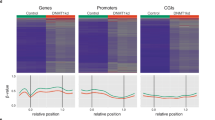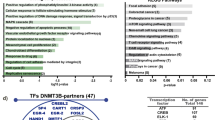Abstract
p53 and DNA methylation play key roles in the maintenance of genome stability. In this work, we demonstrate that the two mechanisms are linked and that p53 plays a role in the maintenance of the DNA methylation levels. The loss of p53 was shown to induce loss of DNA methylation in the TROP1 gene, a human cancer-expressed locus that undergoes amplification when hypomethylated. This demethylation was reverted by the reintroduction of a wild-type TP53 (wtTP53) in the TP53-null cells. Using a gene-amplification assay in vivo, we demonstrate that the loss of p53 leads to a demethylation-dependent TROP1 gene amplification. The induction of gene amplification was reverted by the expression of a wtTP53 gene or by in vitro methylation of the transfected DNA with the Sss I DNA methylase. Taken together, these findings demonstrate that the inactivation of TP53 induces loss of DNA methylation and DNA methylation-dependent gene amplification.
This is a preview of subscription content, access via your institution
Access options
Subscribe to this journal
Receive 50 print issues and online access
$259.00 per year
only $5.18 per issue
Buy this article
- Purchase on Springer Link
- Instant access to full article PDF
Prices may be subject to local taxes which are calculated during checkout








Similar content being viewed by others
References
Ahuja N, Mohan AL, Li Q, Stolker JM, Herman JG, Hamilton SR, Baylin SB and Issa JP . (1997). Cancer Res., 57, 3370–3374.
Alberti S, Nutini M and Herzenberg LA . (1994). Proc. Natl. Acad. Sci. USA, 91, 5833–5837.
Baylin SB, Esteller M, Rountree MR, Bachman KE, Schuebel K and Herman JG . (2001). Hum. Mol. Genet., 10, 687–692.
Bertrand P, Rouillard D, Boulet A, Levalois C, Soussi T and Lopez BS . (1997). Oncogene, 14, 1117–1122.
Bischoff FZ, Yim SO, Pathak S, Grant G, Siciliano MJ, Giovanella BC, Strong LC and Tainsky MA . (1990). Cancer Res., 50, 7979–7984.
Blandino G, Scardigli R, Rizzo MG, Crescenzi M, Soddu S and Sacchi A . (1995). Oncogene, 10, 731–737.
Blobel GA . (2000). Blood, 95, 745–755.
Calabrese G, Crescenzi C, Morizio E, Palka G, Guerra E and Alberti S . (2001). Cytogenet. Cell Genet., 92, 164–165.
Carroll PE, Okuda M, Horn HF, Biddinger P, Stambrook PJ, Gleich LL, Li YQ, Tarapore P and Fukasawa K . (1999). Oncogene, 18, 1935–1944.
Coquelle A, Pipiras E, Toledo F, Buttin G and Debatisse M . (1997). Cell, 89, 215–225.
el-Deiry WS, Nelkin BD, Celano P, Yen RW, Falco JP, Hamilton SR and Baylin SB . (1991). Proc. Natl. Acad. Sci. USA, 88, 3470–3474.
Esteller M, Corn PG, Baylin SB and Herman JG . (2001). Cancer Res., 61, 3225–3229.
Feinberg AP, Gehrke CW, Kuo KC and Ehrlich M . (1988). Cancer Res., 48, 1159–1161.
Fuks F, Burgers WA, Godin N, Kasai M and Kouzarides T . (2001). EMBO J., 20, 2536–2544.
Giulotto E, Knights C and Stark GR . (1987). Cell, 48, 837–845.
Goelz SE, Vogelstein B, Hamilton SR and Feinberg AP . (1985). Science, 228, 187–190.
Hare JT and Taylor JH . (1985). Proc. Natl. Acad. Sci. USA, 82, 7350–7354.
Hollstein M, Sidransky D, Vogelstein B and Harris CC . (1991). Science, 253, 49–53.
Hori TA . (1983). Mutat. Res., 121, 47–52.
Hsieh CL and Lieber MR . (1992). EMBO J., 11, 315–325.
Issa JP, Vertino PM, Wu J, Sazawal S, Celano P, Nelkin BD, Hamilton SR and Baylin SB . (1993). J. Natl. Cancer Inst., 85, 1235–1240.
Jackson-Grusby L, Beard C, Possemato R, Tudor M, Fambrough D, Csankovszki G, Dausman J, Lee P, Wilson C, Lander E and Jaenisch R . (2001). Nat. Genet., 27, 31–39.
Jones PA and Gonzalgo ML . (1997). Proc. Natl. Acad. Sci. USA, 94, 2103–2105.
Laird PW, Jackson-Gursby L, Fazeli A, Dickinson SL, Jung WE, Li E, Weinberg RA and Jaenisch R . (1995). Cell, 81, 197–205.
Laird PW and Jaenisch R . (1994). Hum. Mol. Genet., 3, 1487–1495.
Lengauer C, Kinzler KW and Vogelstein B . (1997). Proc. Natl. Acad. Sci. USA, 94, 2545–2550.
Lengauer C, Kinzler KW and Vogelstein B . (1998). Nature, 396, 643–649.
Levine AJ . (1997). Cell, 88, 323–331.
Livingstone LR, White A, Sprouse J, Livanos E, Jacks T and Tlsty TD . (1992). Cell, 70, 923–935.
Makos M, Nelkin BD, Lerman MI, Latif F, Zbar B and Baylin SB . (1992). Proc. Natl. Acad. Sci. USA, 89, 1929–1933.
Malkin D, Li FP, Strong LC, Fraumeni JFJ, Nelson CE, Kim DH, Kassel J, Gryka MA, Bischoff FZ and Tainsky MA . (1990). Science, 250, 1233–1238.
Mitelman F . (2000). Mutat. Res., 462, 247–253.
Murphy M, Ahn J, Walker KK, Hoffman WH, Evans RM, Levine AJ and George DL . (1999). Genes Dev., 13, 2490–2501.
Patra SK, Patra A and Dahiya R . (2001). Biochem. Biophys. Res. Commun., 287, 705–713.
Perry ME, Rolfe M, McIntyre P, Commane M and Strak GR . (1992). Mutat. Res., 276, 189–197.
Pradhan S and Kim G-D . (2002). EMBO J., 21, 779–788.
Rabbitts TH . (1994). Nature, 372, 143–149.
Robertson KD and Wolffe AP . (2000). Nat. Rev. Genet, 1, 11–19.
Saintigny Y and Lopez BS . (2002). Oncogene, 21, 488–492.
Sambrook J, Fritsch EF and Maniatis T . (1989). Molecular Cloning-A Laboratory Manual, 2nd edn. Cold Spring Harbor Laboratory: New York.
Soares J, Pinto AE, Cunha CV, Andre S, Barao I, Sousa JM and Cravo M . (1999). Cancer, 85, 112–118.
Stein R, Gruenbaum Y, Pollack Y, Razin A and Cedar H . (1982). Proc. Natl. Acad. Sci. USA, 79, 61–65.
Strnad J, Hamilton AE, Beavers LS, Gamboa GC, Apelgren LD, Taber LD, Sportsman JR, Bumol TF, Sharp JD and Gadski RA . (1989). Cancer Res., 49, 314–317.
Tuck-Muller CM, Narayan A, Tsien F, Smeets DF, Sawyer J, Fiala ES, Sohn OS and Ehrlich M .(2000). Cytogenet. Cell Genet., 89, 121–128.
Wahl GM, Robert de Saint Vincent B and DeRose ML . (1984). Nature, 307, 516–520.
Wright JA, Smith HS, Watt FM, Hancock MC, Hudson DL and Stark GR . (1990). Proc. Natl. Acad. Sci. USA, 87, 1791–1795.
Xu GL, Bestor TH, Bourc'his D, Hsieh CL, Tommerup N, Bugge M, Hulten M, Qu X, Russo JJ and Viegas-Pequignot E . (1999). Nature, 402, 187–191.
Yin Y, Tainsky MA, Bischoff FZ, Strong LC and Wahl GM . (1992). Cell, 70, 937–948.
Zheng L, Flesken-Nikitin A, Chen P-L and Lee W-H . (2002). Cancer Res., 62, 2498–2502.
Acknowledgements
We thank Dr M Tainsky for kindly supplying the Li–Fraumeni cells and Drs A Sacchi and E Giulotto for useful discussions. We gratefully acknowledge the support of the Italian Association for Cancer Research (AIRC).
Author information
Authors and Affiliations
Corresponding author
Rights and permissions
About this article
Cite this article
Nasr, A., Nutini, M., Palombo, B. et al. Mutations of TP53 induce loss of DNA methylation and amplification of the TROP1 gene. Oncogene 22, 1668–1677 (2003). https://doi.org/10.1038/sj.onc.1206248
Received:
Revised:
Accepted:
Published:
Issue Date:
DOI: https://doi.org/10.1038/sj.onc.1206248
Keywords
This article is cited by
-
Understanding the versatile roles and applications of EpCAM in cancers: from bench to bedside
Experimental Hematology & Oncology (2022)
-
TP53 R72P polymorphism modulates DNA methylation in hepatocellular carcinoma
Molecular Cancer (2015)
-
EpCAM regulates cell cycle progression via control of cyclin D1 expression
Oncogene (2013)



